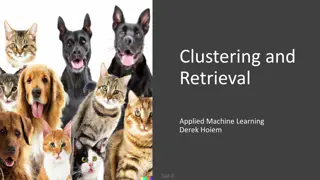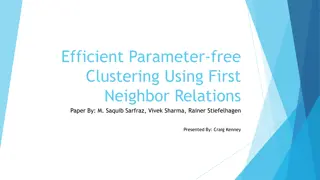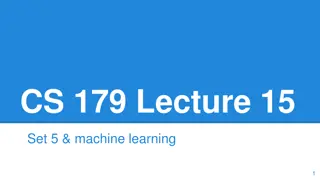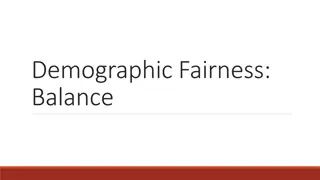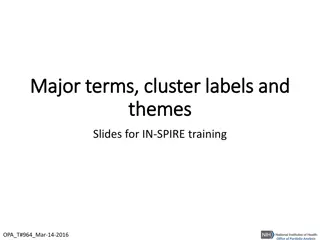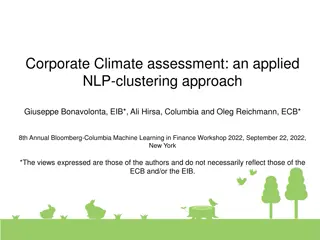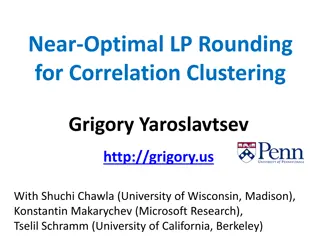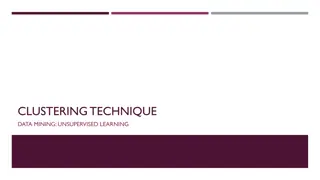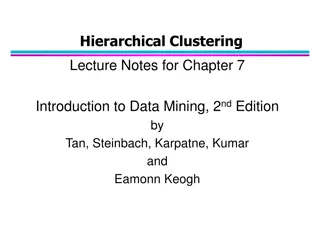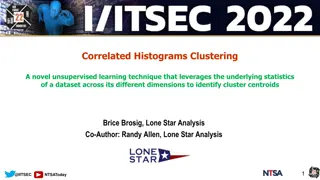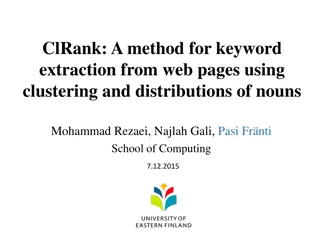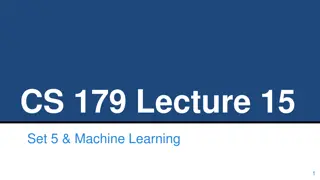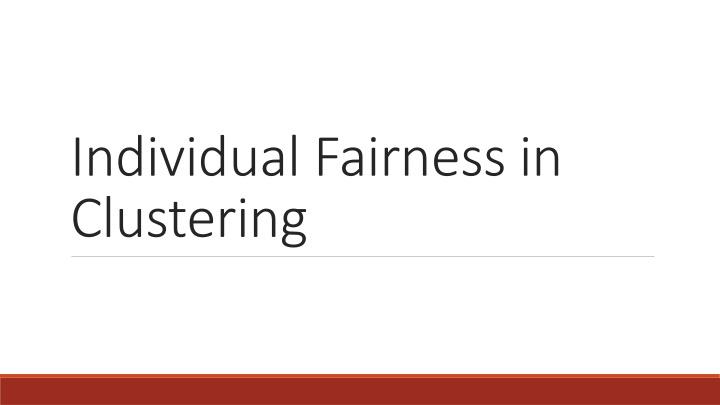
Individual Fairness in Clustering Models
Explore the concept of individual fairness in clustering models, focusing on treating each point fairly based on its own characteristics. Learn about the connection between demographic fairness and individual fairness, as well as key paradigms and models that follow the principles laid out by seminal works such as Dwork et al.'s. Discover how similarity, treatment, and fairness play crucial roles in creating just and effective clustering solutions.
Download Presentation

Please find below an Image/Link to download the presentation.
The content on the website is provided AS IS for your information and personal use only. It may not be sold, licensed, or shared on other websites without obtaining consent from the author. If you encounter any issues during the download, it is possible that the publisher has removed the file from their server.
You are allowed to download the files provided on this website for personal or commercial use, subject to the condition that they are used lawfully. All files are the property of their respective owners.
The content on the website is provided AS IS for your information and personal use only. It may not be sold, licensed, or shared on other websites without obtaining consent from the author.
E N D
Presentation Transcript
Individual Fairness in Clustering
High-Level Motivation Demographic Fairness: Treat each group of points fairly, with respect to how other groups are being treated or with respect to the specific needs of the group at hand. Individual Fairness: Treat each individual point fairly, with respect to how other points are being treated or with respect to its specific needs. Does demographic fairness imply individual fairness? View each point as a singleton group. The concepts of group fairness become vague or ill-defined in this case: Balance: Leads to a single cluster solution Proportionality: Each point is entitled to each its own cluster? Socially fair k-clustering: Reduces to k-center Demographic fairness cannot adequately capture any individual needs of points.
The Seminal Work of Dworket al. A very important work in the area of Individual Fairness Dwork et al. ( Fairness Through Awareness ITCS 2012) introduced a ground breaking concept of individual fairness in the context of classification. Similar individuals should be treated similarly It will help us in our taxonomy of individually fair notions for clustering 1) Definitions that follow the Dwork et al. paradigm 2) Definitions that diverge from it
Individually-Fair Clustering Models that Follow the Dwork et al. Paradigm
The Dworket al. Paradigm in Clustering Similar individuals should be treated similarly Two questions that need to be answered: 1) How can we define similarity in the context of clustering? 2) What constitutes similar treatment in a clustering setting? The first question is not really important. The second question is of much more significance.
Similar treatment in terms of same cluster placement Motivational Example: Suppose a company wants to cluster its employees into k groups People in the first cluster will receive the highest amount of raise, the people in the second cluster the second highest raise, and so on. Suppose that employee X is very similar to employee Y. If Y is placed in a cluster that receives a better amount of raise, then X would arguably feel unfairly treated. In such cases, similar points should be placed in the same cluster
Probabilistic Pairwise Fairness Definition of Similarity Introduced by Brubach et al. ( A Pairwise Fair and Community-preserving Approach to k-Center Clustering ICML 2020) Definition of similarity: For every pair of points ?,? ? we are given a value ??,? [0,1] indicating their true similarity. The smaller ??,? is the more similar the two points. The values ? can be different from the metric ?: 1) Encoding of redundant features in ? 2) can be the similarity as perceived by the individuals
Probabilistic Pairwise Fairness Definition of Similar Treatment How can we mitigate unfair behavior? Avoid situations where two similar points are deterministically separated Randomization can imply fairness Seek a randomized solution that separates ?,? with probability at most ??,? Choose ? with ? ? Construct efficiently sampleable distribution ? over assignments ?:? ? such that Pr ~?[? ? ?(? )] ??,? Minimize some metric related objective
Probabilistic Pairwise Fairness - Results Brubach et al. ( A Pairwise Fair and Community-preserving Approach to k-Center Clustering ICML 2020) introduced the problem and gave a ????-approximation algorithm for the k-center objective. The algorithm works when ??,? = {? ?,? ? ,1} , for some ? > 0. Very efficient algorithm Bounded PoF Brubach et al. ( Fairness, Semi-Supervised Learning, and More: A General Framework for Clustering with Stochastic Pairwise Constraints AAAI 2021) gave constant factor approximations for all k-center, k-median and k-means The values ??,? are arbitrary Not that efficient LP based
Distributional Individual Fairness Introduced by Anderson et al. ( Distributional Individual Fairness in Clustering Arxiv 2020). Similarity defined exactly as in Brubach et al. That is with values ??,? Pick ? ? with ? ? For each ? ? find distribution ??over ? Fairness constraint: Metric ? measuring statistical proximity ? ??,?? ??,? Difference with the model of Brubach et al. Brubach et al. return an actual assignment ?:? ? Brubach et al. upper bound the separation probability Example: For ?,? both ??and ?? are the uniform distribution over ? Anderson et al. give constant factor approximation algorithms for all k-center, k-median and k-means
Similar Treatment is Terms of the Assignment Distance In many applications the quantity ? ?,? ? (assignment distance) is what really matters Clustering: It measures how representative ? ? is for ?. Facility Location: It represents the distance ? needs to travel in order to reach its service provider ? ? . The smaller ? ?,? ? more satisfied the point ?. is the Suppose ? is similar to ? and ? ? ,? ? ? ?,? ? . ? is justified to feel unfairly treated
Motivational Example The points of ? correspond to users of an e-commerce site. ?(?,? ) measures how similar the profiles of ? and ? are. The website wants to choose ? representative users ? ? (according to some objective function) and construct an assignment ?:? ?. User ? will receive recommendations based on ?(?) s profile. The smaller ? ?,? ? is the more relevant the recommendations ? receives. If ? considers ? as similar to itself, then it perceives ? ? ,? ? treatment. ? ?,? ? as unfair
-Equitable k-Center Introduced by Chakrabarti et al. ( A New Notion of Individually Fair Clustering: -Equitable k-Center AISTATS 2022) Every point ? has a set of other points ?? ? that it perceives as similar to itself This is how similarity is modeled in this work Has advantages over the modeling with the ? values: more easily constructable We are also given a value ? 1. Ask for ? ? ( ? ?) and assignment ?:? ? that minimize the k-center objective max ? ??(?,?(?)) . Fairness Constraint: For every ? ? and ? ??ensure that ? ?,? ? The smaller is the smaller ? ? ,? ? remains ? ? ? ,? ? ? ?,? ?
The parameter ? ?,? ? ? ? ,? ? The smaller is the smaller remains. = 4 = 1 A value of close to 1 would give the most equitable/fair solution For what values of is the problem well- defined? For ? < 2 there exist instances that admit no feasible solution For ? 2 we can always find a feasible solution
The results of Chakrabarti et al. A very efficient algorithms that returns a solution of cost 5 ? + ?? ? is the value of the optimal solution ??= max ? ?,? ???(?,? ) When ? is a good estimate of similarity: ??= ?(? ) Under some mild conditions on the sets ??the algorithm has bounded PoF
Notions of Individual Fairness in Clustering that do not follow the Dwork et al. paradigm
A Center in my Neighborhood Suppose we want to solve a classical k- clustering problem on a set of points ? Find ? ? (|?| ?) and assignment ?:? ? that ? ?? ?,? ? ?is minimized Even though the global objective function might be minimized, individual points may have different requirement in terms of ?(?,?(?)) Recall the vaccine site allocation example. Each ? has a value ??, and we should make sure that ?(?,?(?)) ??
Results Jung et al. ( A Center in Your Neighborhood: Fairness in Facility Location FORC 2020) introduced the problem Important result: Even finding a feasible solution to the problem is NP-hard. Goal: Find ?,? -bicriteria algorithms: ? ?? ?,? ? ?(?,?(?)) ? ??for every ? ? ? OPT A series of papers gave increasingly better results: 1) Mahabadi and Vakilian ( Individual Fairness for k-Clustering - ICML 2020). (? ? ,7)-bicriteria 2) Chakrabarty and Negahbani ( Better Algorithms for Individually Fair k-Clustering NeurIPS 2021) (21+2 3) Vakilian and Yal ner ( Improved Approximation Algorithms for Individually Fair Clustering AISTATS 2022) (16?,3)-bicriteria ?,8)-bicriteria
Individual Fairness in Clustering with Outliers Pick ? ? with ? ? Pick ? ? with ? ? (points to be clustered) Being an outlier is disadvantageous!!! We have seen how to protect against demographic bias What can be interpreted as bias against individuals? Deterministically be chosen as an outlier in every computed solution
Randomization saves the day: A lottery model for individually fair clustering with outliers For each ? ? we are given a value ?? [0,1] We want a distribution ? over solutions (?,?) such that: 1) For every (?,?) drawn from ? we have S k and ? ?. 2) Pr S,? ~?j ? pjfor every j ? 3) Some objective is minimized We avoid scenarios where certain points are deterministically chosen as outliers Through the values ??we can capture a plethora of fairness concepts: Equitable treatment: ??is the same for all points Preferential treatment: Points in greater need of service get a higher ??value
Results The problem has only been studied under the k-center objective. It was introduced by Harris et al. ( A Lottery Model for Center-Type Problems With Outliers APPROX-RANDOM 2017) Harris et al. gave a pseudo 2-approximation algorithm. In every solution drawn from ? the coverage guarantee is 1 ? ? Pr S,? ~?j ? (1 ?)pj Anegg et al. ( A Technique for Obtaining True Approximations for k-Center with Covering Constraints IPCO 2020) gave a true 4-approximation algorithm.
Fairness based on average distance to the points in your cluster Motivational Example: Suppose a company wants to cluster its employees into k groups, based on their performance rating for some specific year. Let s assume that people in the first cluster will receive the highest amount of raise, the people in the second cluster the second highest raise, and so on. Consider some employee X placed in some cluster C. Let ??be the average distance of X to the rest of the points in C. If there exists cluster W, with ??be the average distance of X to the of the points in W, such that ?? ??, then X would arguably feel unfairly treated
Formal Definition and Results Given a set of points ?, partition it into ? sets ?1, ,??such that: For every ? ? and each j ??, 1 1 ?? ? ?? ?(?,? ) for all ? ? ?? 1 ? ???(?,? ) The problem was introduced by Kleindessner et al. ( A Notion of Individual Fairness for Clustering Arxiv 2020). Main result: For ? 2, it is NP-hard to decide if such a clustering exists When the metric space is the Euclidean line, the problem can be solved efficiently.

